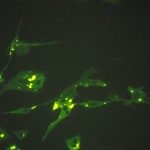Link to Pubmed [PMID] – 21522083
Molecules 2011;16(5):3499-518
Given the growing number of diseases caused by emerging or endemic viruses, original strategies are urgently required: (1) for the identification of new drugs active against new viruses and (2) to deal with viral mutants in which resistance to existing antiviral molecules has been selected. In this context, antiviral peptides constitute a promising area for disease prevention and treatment. The identification and development of these inhibitory peptides require the high-throughput screening of combinatorial libraries. Phage-display is a powerful technique for selecting unique molecules with selective affinity for a specific target from highly diverse combinatorial libraries. In the last 15 years, the use of this technique for antiviral purposes and for the isolation of candidate inhibitory peptides in drug discovery has been explored. We present here a review of the use of phage display in antiviral research and drug discovery, with a discussion of optimized strategies combining the strong screening potential of this technique with complementary rational approaches for identification of the best target. By combining such approaches, it should be possible to maximize the selection of molecules with strong antiviral potential.
